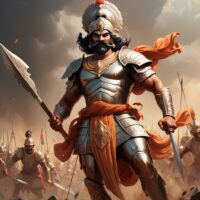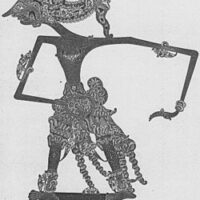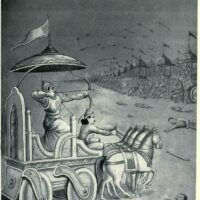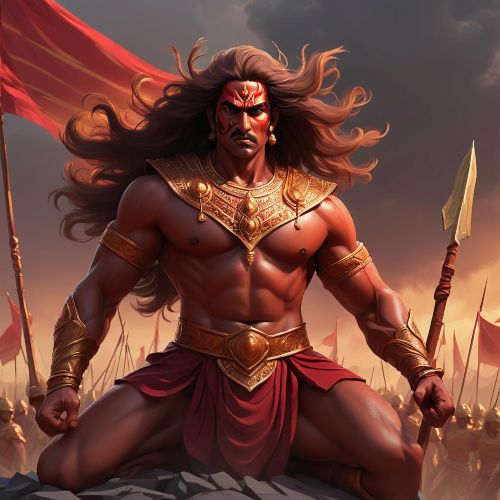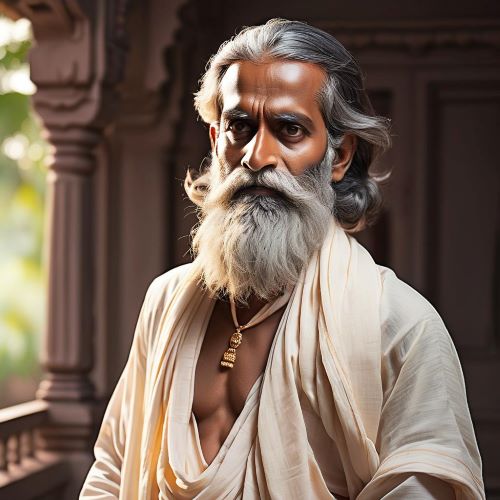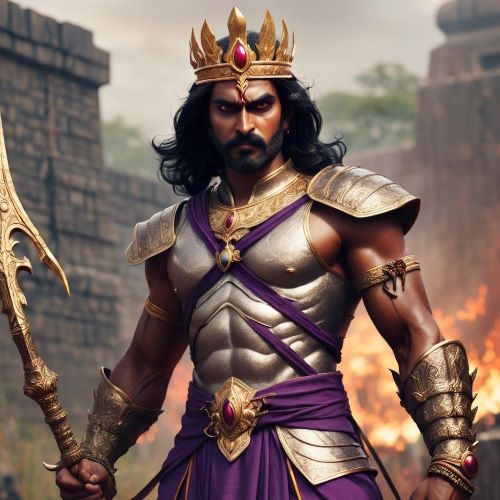Satyaki : The Loyal Warrior
Listen
At a glance
| Description | |
|---|---|
| Origin | Asian Mythology |
| Classification | Mortals |
| Family Members | Satyaka (Father) |
| Region | India, Indonesia |
| Associated With | Bravery, Loyalty, Warfare |
Satyaki
Introduction
Satyaki, also known as Yuyudhana, is one of the most admired warriors in the Mahabharata. A kinsman of Krishna and a disciple of Arjuna, Satyaki is celebrated for his loyalty, martial brilliance, and dedication to dharma. His reputation as a valiant archer who stood by the Pandavas in their struggle against the Kauravas secures him a central place among the epic’s heroes. Beyond India, Satyaki’s character appears in the cultural traditions of Indonesia, especially in Javanese Wayang Kulit performances, where he is reimagined within local aesthetics. This dual presence highlights the enduring appeal of Satyaki as a symbol of devotion and martial integrity across different cultures.
Physical Traits
In Indian traditions, Satyaki is often portrayed as a warrior of great strength, endurance, and skill. Though the Mahabharata provides limited physical description, his ability to duel with veterans such as Drona and Bhurisravas reveals not only stamina but also exceptional mastery of weaponry. Artists and storytellers have often depicted him wearing white attire, a color associated with purity and righteousness, while his bow and quiver signify his identity as a supreme archer. His battlefield presence was commanding, marked by energy and swiftness that allowed him to face warriors who were considered almost invincible.
In Indonesian Wayang Kulit, Satyaki is represented with the stylized artistic conventions typical of Javanese puppetry. Figures are given elongated limbs, graceful hand movements, and intricately designed costumes that highlight their role and moral stature. Known locally as Setyaki, his puppet form emphasizes elegance and nobility rather than physical realism, reflecting the symbolic interpretation of his character within Javanese art.
Family
Satyaki was born into the Vrishni branch of the Yadava dynasty, the same lineage as Krishna and Balarama. His father was Satyaka, while his grandfather Shini was famed for supporting the Pandavas’ ancestors during earlier conflicts. This illustrious lineage placed Satyaki at the heart of Yadava politics and kinship ties. Although he shared blood relations with Kritavarma, who supported the Kauravas, Satyaki chose to align with Krishna and the Pandavas. His choice demonstrates the moral dilemmas within the Yadava clan during the Kurukshetra War, where loyalty to dharma sometimes outweighed bonds of blood.
Later texts mention his descendants, including a son named Jaya, though his legacy is more closely tied to his personal deeds. His family background underscores the intersection of kinship, politics, and dharma that shaped his destiny as a warrior.
In Indonesian mythology, genealogical details are often adapted to suit local traditions. The Wayang adaptations may retain his kinship with Krishna and Arjuna but reinterpret family dynamics to resonate with Javanese cultural values. Such adaptations demonstrate how mythology travels, transforms, and takes on fresh meanings in new cultural settings.
Other names
Satyaki is frequently referred to by the name Yuyudhana, which means “one eager to fight.” This epithet encapsulates his martial zeal and readiness to engage in battle for justice. Other names in Sanskrit texts emphasize his Yadava heritage, calling him Yadūdvaha (the best among the Yadavas) or Yaduvīra (the heroic Yadava). These names not only situate him within his clan but also underline his valor and prominence among Krishna’s kin.
In Indonesia, the name often shifts in spelling and pronunciation to Setyaki, reflecting the Javanese adaptation of Sanskrit words. This localized form has become widely recognized in Wayang Kulit theater, where Setyaki embodies the archetype of the loyal warrior. Such linguistic transformations ensured that Indian epics became accessible and meaningful to local audiences while preserving the essence of the characters.
Powers and Abilities
Satyaki’s powers and abilities are described with great admiration in the Mahabharata. A direct disciple of Arjuna, he mastered advanced archery techniques and celestial weapons, excelling in precision and speed. His role in the Kurukshetra War was not merely symbolic; he fought fiercely in some of the most crucial duels. Among his remarkable feats was defending Yudhishthira from Drona’s relentless attacks, a task that required both skill and courage.
One of the most debated episodes in his life is his confrontation with Bhurisravas. After a long and exhausting duel, Bhurisravas was disarmed and sat down in meditation, but Satyaki, recalling earlier insults and attacks, struck him down. This act was controversial, criticized as a breach of warrior ethics, yet it highlights the complexity of Satyaki’s character. He was not merely a flawless hero but a human figure grappling with rage, loyalty, and the code of war.
In Wayang performances, Satyaki’s strength and valor are conveyed not through detailed accounts of weaponry but through stylized gestures and narrative emphasis. His character is depicted as a loyal Pandava ally, embodying values of bravery and righteousness that align with Javanese ideals of moral conduct.
Modern Day Influence
Satyaki’s legacy continues to resonate in both India and Southeast Asia. In India, he remains an important figure in retellings of the Mahabharata, where his loyalty to Arjuna and Krishna is remembered as an example of dharma-guided friendship. His controversial slaying of Bhurisravas is also frequently discussed in ethical and philosophical discourses, inviting reflection on the boundaries of duty and morality in moments of conflict.
In Indonesia, his presence in Wayang Kulit has given him a new cultural life. As Setyaki, he is featured in shadow-puppet performances that merge Indian epic narratives with Javanese symbolism, often adapted to convey lessons about leadership, loyalty, and spirituality. These performances, once tied to religious ceremonies, remain part of cultural festivals and traditional art, ensuring that Satyaki’s story continues to be shared across generations.
Beyond theater, Satyaki’s story is relevant in modern studies of ethics, leadership, and cultural exchange. Scholars exploring the psychological and moral lessons of the Mahabharata often cite him as an example of a warrior who embodies both loyalty and complexity. His dual legacy—in Indian epics and Indonesian adaptations—illustrates how mythological figures can transcend borders and remain meaningful in diverse societies.
Related Images
Source
Wikipedia contributors. (2023). Satyaki. Wikipedia. https://en.wikipedia.org/wiki/Satyaki
Apam Napat. (2023). Satyaki – Disciple of Arjuna – Indian Mythology. https://apam-napat.com/satyaki/
Tales of Sanatan. (2023). Satyaki: The Valiant Warrior Devoted, Loyal, and Condemned. https://www.talesofsanatan.com/satyaki-the-valiant-warrior-devoted-loyal-and-condemned/
Vyasa Online. (2023). Satyaki – Vyasa Mahabharata. VyasaOnline.com. https://www.vyasaonline.com/encyclopedia/satyaki/
Frequently Asked Questions
What is lorem Ipsum?
I am text block. Click edit button to change this text. Lorem ipsum dolor sit amet, consectetur adipiscing elit. Ut elit tellus, luctus nec ullamcorper mattis, pulvinar dapibus leo.
What is lorem Ipsum?
I am text block. Click edit button to change this text. Lorem ipsum dolor sit amet, consectetur adipiscing elit. Ut elit tellus, luctus nec ullamcorper mattis, pulvinar dapibus leo.
What is lorem Ipsum?
I am text block. Click edit button to change this text. Lorem ipsum dolor sit amet, consectetur adipiscing elit. Ut elit tellus, luctus nec ullamcorper mattis, pulvinar dapibus leo.
What is lorem Ipsum?
I am text block. Click edit button to change this text. Lorem ipsum dolor sit amet, consectetur adipiscing elit. Ut elit tellus, luctus nec ullamcorper mattis, pulvinar dapibus leo.
What is lorem Ipsum?
I am text block. Click edit button to change this text. Lorem ipsum dolor sit amet, consectetur adipiscing elit. Ut elit tellus, luctus nec ullamcorper mattis, pulvinar dapibus leo.


